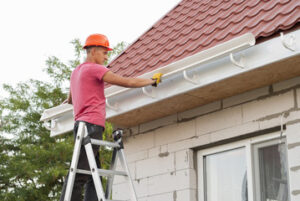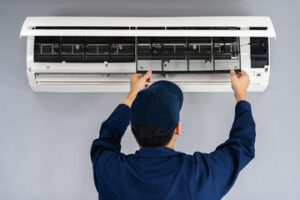Charleston Gutter Cleaning is an essential component of home maintenance that ensures the longevity and sturdiness of your building. It also prevents the costly water damage that results from clogged gutters.

Gutter cleaning should be done at least twice a year. However, the timing depends on the property. Homes that have trees that produce early spring blossoms, helicopter seed pods and pollen sacs require an earlier gutter cleaning.
When your gutters are clogged, they lose their ability to direct rainwater away from the home. Instead, rainwater pools around the property and causes foundation damage, roof damage, and other issues. This is why it’s important to clean your gutters regularly.
Gutter cleaning is a DIY job, but you need the right equipment to do it safely and effectively. You’ll need a ladder, a tool to scoop debris out of the gutter (like a garden trowel or hand rake), and a bucket or garbage bag for the debris you remove. It’s also a good idea to wear work gloves and have someone help you on the ladder.
Start by scooping out the large debris like leaves and twigs from the gutter. Then, work your way down the length of the gutter, checking the downspout for a clog as you go. Once you’ve removed all the debris, run water from a hose through the downspout to see if it flows freely. If not, try using a plumber’s snake or pressure washer to clear the clog.
Standing water in the gutter can also lead to mold growth and deterioration of the surrounding landscaping. It can erode soil and even crack concrete. It’s also a breeding ground for mosquitoes, flies, and rodents, which can then infest your home. Regular gutter cleaning prevents this from happening by removing pest-attracting debris.
Gutters serve a fundamental function in a roofing system, diverting rainwater from the home’s surface and directing it to the downspout for drainage. If the gutters are clogged, the water can’t flow and pools around the foundation and other outdoor equipment like HVAC units. Over time, this can rust and corrode the external metal components of these units.
Clogged gutters can also rot, pull away from the house, or fall off completely. They can cause leaks and other problems that are expensive to fix. Some home warranty companies even have a stipulation that homeowners conduct regular gutter cleaning or risk paying for the cost of roof repairs or replacement out of pocket.
Clogged gutters can lead to pest infestations.
Clogged gutters filled with stagnant water and decaying leaves become breeding grounds for pests like mosquitoes, rodents, carpenter ants, and birds. These insects pose health and property risks to your home, garden, and yard. Mosquitoes, for example, can carry diseases and cause irritation to the skin. Meanwhile, rodents and birds can damage your roof and attic while searching for food and nesting materials.
Standing water from clogged gutters can also cause soil erosion in your landscaping. It can wash away plant roots and destroy the structure of sidewalks, driveways, and other outdoor surfaces. Furthermore, it can seep through cracks in your foundation and weaken the overall structure of your home.
Regular gutter cleaning helps to avoid these issues by preventing overflow of rainwater. Gutters, when properly installed and maintained, are designed to direct water flow away from your home’s foundation, walls, and landscaping. However, if your gutters are clogged with debris and silt, it will overflow and cause these issues.
Aside from causing structural damage, overflowing gutters can also infiltrate your house, creating damp environments that promote the growth of harmful microorganisms. These can lead to respiratory problems such as coughing, wheezing, and throat irritation. Additionally, they can worsen existing conditions such as asthma and allergies.
Gutter cleaning is a crucial part of home maintenance, but it’s often neglected. It’s important to hire professional gutter cleaners, like the team at Squeegee Squad, who are familiar with proper safety protocols and have the necessary equipment to perform this task safely. Attempting to clean your own gutters can lead to injuries such as broken bones and concussions, making it risky for your family’s health and well-being.
A well-functioning gutter system is essential to protecting your home from costly repairs and preserving the beauty of your landscape. Clogged gutters can cause a variety of damage, from roof leaks to foundation cracks and siding deterioration. To prevent this from happening, it’s important to have your gutters regularly cleaned and inspected by a professional. A well-maintained gutter system can protect your home from damage, improve its curb appeal, and keep your family healthy.
Clogged gutters can lead to mold growth.
When gutters are full of debris, water cannot properly flow into and down the downspout. Instead, it seeps under the shingles, causing rot and leaks. It can also penetrate behind siding and window frames, causing mold and mildew growth. It can even erode the foundation of your home or building, potentially leading to structural damage. This can be extremely costly, and may require repainting and even replacement of the foundation.
Gutter cleaning helps prevent mold growth, pest infestations, and structural damage by ensuring that the water is properly channeled away from the property. In addition, clean gutters help to maintain the aesthetics of your home, preventing unsightly stains and overflows that detract from the curb appeal of your home.
Aside from the structural and cosmetic damage that clogged gutters can cause, they can also be hazardous to your health. Standing water in clogged gutters provides the perfect breeding ground for mosquitoes, flies, and rodents. In addition, the decomposing leaves and debris in clogged gutters can create a habitat for mold, which can be harmful to your family’s health.
Gutters play a critical role in protecting your home’s foundation, exterior walls, and landscaping. Gutter cleaning is essential to keep your home safe, especially in South Carolina where rainstorms are frequent and strong. Keeping your gutters free of twigs, pine needles, leaves, and debris is the best way to ensure that they are able to perform their function.
Clogged gutters can lead to structural damage.
The buildup of leaves, twigs, and dirt in gutters can cause blockages that prevent water from flowing freely. When this occurs, your gutters may overflow and spill onto the ground or seep into your home, leading to damage that can be costly to repair. In some cases, clogged gutters can even lead to complete gutter failure.
If you notice water spilling over the sides of your gutters during a rainstorm or staining your home’s exterior walls, these are clear indications that your gutters are clogged and not working properly. Standing water in the gutters can also encourage the growth of mold and mildew, which pose health risks for your family.
Clogged gutters can also impact your roof’s structure and the integrity of your home’s foundation. If water pools around your foundation, it can soften the soil and weaken its integrity over time, which can lead to cracks and eventually structural failure. If water seeps into your basement, it can also rot the supports and foundation materials, leading to expensive repairs or even full foundation replacement.
Regular gutter cleaning and maintenance is an affordable and effective way to protect the value of your home. In addition to preventing water and pest damage, clean gutters can help prolong the life of your roof, siding, fascia boards, and wood trim. In addition, water and debris that accumulates in the gutters can damage your driveway, walkways, or landscaping. Finally, clogged gutters can detract from your home’s curb appeal and lower its resale value. Gutter repair or replacement can be a significant investment, so prioritizing regular maintenance is an important step to protecting your home’s integrity and value.








